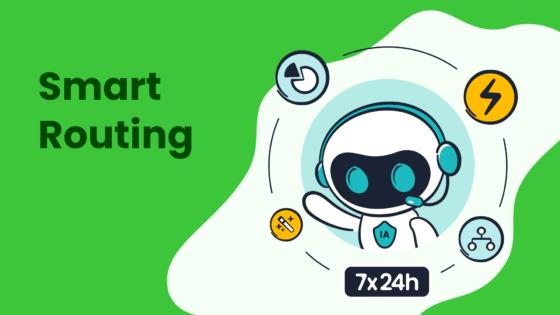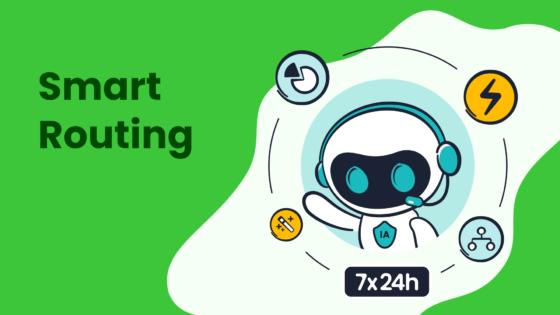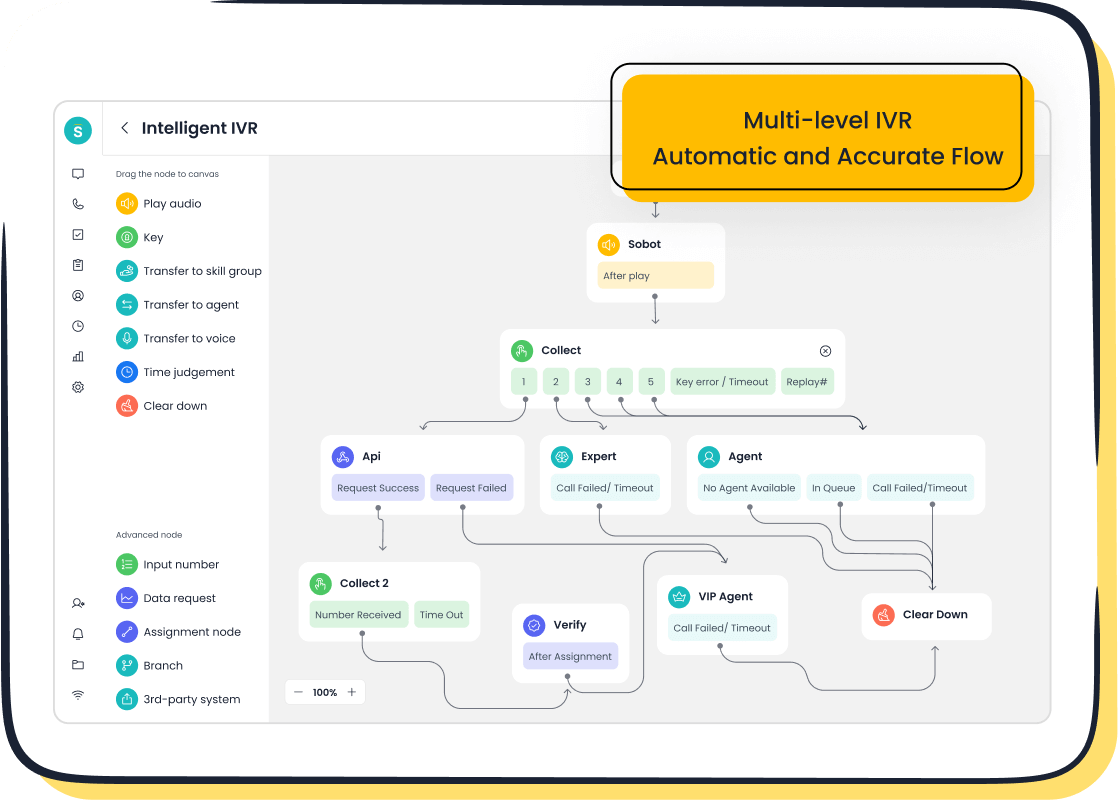The Importance of First Response Time in Enhancing Customer Satisfaction

Imagine reaching out to a company with a question or concern and receiving a fast reply within minutes. That quick response time instantly reassures you, showing the business values your time and needs. First response time isn’t just a metric; it’s the foundation of trust and satisfaction in customer interactions. When you respond quickly, you eliminate frustration and create a positive experience from the start. Sobot helps businesses achieve this by offering tools like its intelligent Voice/Call Center, designed to reduce first reply time and optimize customer engagement.
Studies show that 66% of customers expect businesses to respond within ten minutes when contacting them online. Meeting these expectations with fast replies can make or break customer loyalty.
What Is First Response Time and Why Does It Matter?
Definition and Importance of First Response Time
First response time refers to the duration between when a customer submits a query and when they receive the initial response from your team. This metric is more than just a number; it’s a reflection of how much you value your customers’ time. A quick initial response reassures customers that their concerns are being addressed, setting the tone for a positive interaction.
"A quick first response time is a key way to build customer trust, letting customers know right away that you are taking their inquiry seriously and that you will resolve the issue as fast as possible." — Bri Christiano, Director of Customer Support at Gorgias
Research shows that 90% of U.S. customers consider an immediate response important or very important. Additionally, 60% expect support within 10 minutes or less. Meeting these expectations can significantly enhance customer trust and satisfaction.
How Average First Response Time Impacts Customer Experience
The average first response time directly influences how customers perceive your service. A delay in the initial response can lead to frustration, while a prompt reply creates a sense of reliability. For instance:
- 33% of customers report that waiting on hold is their biggest frustration.
- 53% find three minutes an acceptable wait time for phone support.

By reducing the average first response time, you can improve key customer experience metrics like satisfaction and loyalty. Tools like Sobot’s Voice/Call Center help contact centre managers achieve this by automating workflows and routing calls efficiently, ensuring faster responses.
Measuring customer service metrics, such as first response time, is essential. It allows you to identify bottlenecks and optimize your processes, ultimately improving service quality.
Industry Benchmarks for First Response Time in Customer Service
Understanding industry benchmarks helps you set realistic goals for your team. Here’s a quick overview:
| Communication Channel | Standard Response Time | Best-in-Class Response Time |
|---|---|---|
| 1 hour (89% of customers) | 1-2 hours | |
| Live Chat | Seconds | Under 30 seconds |
| Phone Support | 2 minutes | Under 2 minutes |
| 1 hour (78% of customers) | N/A | |
| 4 hours | N/A |

These benchmarks highlight the importance of speed across all channels. With Sobot’s omnichannel solutions, you can unify customer interactions and meet these standards effortlessly. Features like smart call routing and AI-powered voicebots ensure your team delivers exceptional service every time.
The Role of First Response Time in Customer Satisfaction

Meeting Customer Expectations with Speed
In today’s fast-paced world, customers expect immediate attention. When you respond quickly, you show that you value their time and concerns. Meeting these expectations is not just about speed; it’s about creating a good interaction that leaves a lasting impression. Studies reveal that businesses prioritizing quick replies often achieve higher customer satisfaction and retention rates.
| Evidence Description | Source |
|---|---|
| A study by the CMO Council found that quick response time is the most significant factor leading to customer satisfaction. | CMO Council Study |
| Survey results indicate that businesses that value customer time score high in customer retention. | CMO Council Study |
Sobot’s Voice/Call Center ensures your agents can meet these expectations effortlessly. Features like smart call routing and real-time monitoring allow your team to handle inquiries efficiently, reducing delays and enhancing the customer experience. By leveraging such tools, you can consistently deliver a positive customer experience that builds trust and loyalty.
The Psychological Impact of Quick Responses on Customer Perception
A quick response does more than resolve issues—it shapes how customers perceive your brand. When you reply promptly, customers feel valued and respected. This psychological impact fosters trust and strengthens your relationship with them. Research highlights that consistent communication reassures customers, making them feel informed and cared for.
- A sincere response can alleviate tension and enhance customer perception.
- Exceptional care leads to positive word-of-mouth, reinforcing brand loyalty.
Imagine a customer reaching out with an urgent query. A delayed response might leave them frustrated, while a prompt reply reassures them that their concerns matter. Sobot’s AI-powered voicebots and unified workspace enable your agents to provide quick replies, ensuring every interaction feels personal and attentive. This approach not only improves customer satisfaction but also enhances your brand’s reputation.
How First Response Time Influences Customer Loyalty and Retention
First response time plays a pivotal role in retaining customers. A fast initial reply sets the tone for the entire interaction, making customers more likely to stay loyal to your brand. Businesses that prioritize quick responses often see higher Net Promoter Scores (NPS) and improved retention rates. Measuring customer satisfaction through KPIs like NPS and Customer Effort Score (CES) helps you understand how well you’re meeting expectations.
- Measuring customer satisfaction is essential for understanding if expectations are met.
- Key Performance Indicators (KPIs) such as NPS, CES, and CSAT are crucial for evaluating customer experience initiatives.
Sobot’s omnichannel solutions make it easy to track these metrics while optimizing your team’s performance. For example, Michael Kors achieved an 83% reduction in response time using Sobot’s platform, leading to a 95% customer satisfaction rate. By investing in tools that enhance first response time, you can foster loyalty and ensure long-term success.
How First Response Time Affects Contact Center Performance
The Link Between Response Time and Operational Efficiency
Reducing first response time doesn’t just improve customer satisfaction—it transforms your contact center’s operational efficiency. When your agents respond quickly to customer queries, they can resolve issues faster, reducing the overall workload and freeing up resources for other tasks. This efficiency directly impacts key metrics that define your call center’s success.
- First Response Time (FRT): A lower FRT reflects your team’s ability to address customer queries promptly, leading to higher satisfaction rates.
- First Call Resolution (FCR): Quick responses increase the likelihood of resolving issues on the first interaction, minimizing repeat calls and boosting efficiency.
- Customer Satisfaction (CSAT): Faster response times correlate with higher CSAT scores, as customers feel valued and supported.
Sobot’s Voice/Call Center empowers your team to achieve these results. Features like smart call routing and AI-powered voicebots streamline workflows, ensuring your agents can focus on resolving issues rather than navigating inefficiencies. By optimizing these processes, you can elevate your contact center’s performance and deliver exceptional customer service.
Real-World Examples: How Sobot’s Voice/Call Center Improves First Response Time
Michael Kors, a global luxury fashion brand, faced challenges in managing customer queries efficiently. By implementing Sobot’s Voice/Call Center, they achieved an 83% reduction in response time. This improvement not only enhanced their operational efficiency but also led to a 95% customer satisfaction rate.
Sobot’s platform offers tools like real-time monitoring, intelligent IVR, and unified workspaces that enable agents to handle inquiries faster. For example, the smart call routing feature ensures that calls are directed to the most qualified agent, reducing wait times and improving first-call resolution rates. Additionally, the AI-powered voicebot handles repetitive queries, allowing agents to focus on more complex issues.
These features demonstrate how Sobot’s solutions can transform your contact center into a high-performance operation. By reducing response times, you can create a seamless experience for your customers while optimizing your team’s productivity.
The Role of Analytics in Identifying Bottlenecks and Improving Metrics
Analytics play a crucial role in uncovering inefficiencies that slow down response times. Tools like AI productivity analysis systematically examine call data and agent performance to identify bottlenecks. By analyzing metrics such as peak call times, response rates, and customer feedback, you can pinpoint areas for improvement and implement actionable strategies.
Key analytical methods include:
- Real-time Monitoring: Track ongoing operations to address issues immediately.
- Historical Data Analysis: Identify trends and recurring challenges over time.
- Pattern Recognition: Use algorithms to detect anomalies and forecast future performance.
Sobot’s Voice/Call Center integrates advanced analytics to help you optimize your operations. For instance, call volume analysis identifies peak times, enabling you to adjust staffing levels accordingly. Agent performance metrics, such as average handle time and first-call resolution, provide insights into individual and team efficiency. Additionally, IVR system effectiveness can be evaluated to reduce call abandonment rates and improve menu navigation.
By leveraging these insights, you can refine your processes, reduce first response time, and enhance overall performance. Analytics not only improve operational efficiency but also ensure your team consistently delivers exceptional customer service.
Measuring and Tracking First Response Time Effectively
Tools and Metrics for Monitoring First Response Time
Tracking response time metrics is essential for improving your customer service operations. Several tools and metrics can help you monitor and optimize performance effectively:
- Helpdesk systems and customer support dashboards automatically track response times, offering real-time data and historical trends.
- Tools like Dynatrace and Datadog provide advanced analytics and custom dashboards to monitor performance.
- Metrics such as average response time and First Response Time (FRT) help evaluate how quickly agents address customer inquiries.

Using these tools ensures you can identify areas for improvement and maintain accountability. For example, Sobot’s Voice/Call Center integrates real-time monitoring and analytics, enabling you to track FRT effortlessly. This feature helps your agents respond faster, ensuring a seamless customer experience.
Leveraging Sobot’s Unified Workspace for Accurate Tracking
Sobot’s Unified Workspace is a game-changer for tracking first response time. It consolidates all customer interactions into a single platform, giving your agents instant access to customer data and communication history. This unified view eliminates delays caused by switching between systems, allowing agents to focus on resolving issues quickly.
The platform also automates the measurement of response time metrics, reducing manual errors and providing accurate insights. For instance, Sobot’s system tracks FRT within business hours, ensuring fair and precise reporting. By leveraging this feature, you can set clear response time goals and hold your team accountable for meeting them.
Setting Realistic Benchmarks for Your Contact Center
Establishing realistic benchmarks is crucial for maintaining high performance in your contact center. Start by aligning your goals with customer expectations. Industry reports can provide valuable insights into competitive standards, helping you set achievable targets.
Here’s a step-by-step approach:
- Identify gaps between customer expectations and actual service experiences.
- Focus on customer satisfaction rather than just operational metrics.
- Adapt benchmarks to reflect changing conditions, such as agent workloads or industry trends.
Sobot’s analytics tools simplify this process by offering data-driven insights. For example, you can analyze peak call times and agent performance to adjust staffing levels and improve efficiency. By setting benchmarks that prioritize customer satisfaction, you’ll create a more responsive and effective customer support platform.
Actionable Strategies to Improve First Response Time

Automating Responses with AI-Powered Tools
Automation is a game-changer when it comes to improving response efficiency. AI-powered tools, like Sobot’s intelligent voicebots, can handle repetitive queries instantly, freeing up your agents to focus on more complex issues. These tools work 24/7, ensuring customers receive help anytime, even outside business hours. By understanding customer intent through advanced language models, AI systems provide accurate and context-aware responses, reducing the need for follow-ups.

For example, AI tools improve over time by learning from every interaction. This leads to higher first-contact resolution rates and more efficient service. Businesses also benefit from cost savings, as automation reduces operational expenses while maintaining scalability. Sobot’s Voice/Call Center integrates AI seamlessly, offering proactive support and actionable insights to enhance your customer service operations.
| Benefit | Description |
|---|---|
| Cost Savings | Automating customer service functions can significantly reduce operational costs. |
| Proactive Support | AI uses predictive analytics to anticipate customer needs and resolve issues before they arise. |
| Scalability | AI solutions can handle growing volumes of customer interactions without compromising quality. |
Training Customer Service Teams for Faster First Responses
Your customer service agents are the backbone of your operations. Equipping them with the right skills ensures they can respond quickly and effectively. Targeted coaching helps agents refine their techniques, while personalized training programs address individual needs. For instance, integrating tools like call recording systems allows agents to analyze common inquiries and prepare better responses.
Investing in training not only improves response times but also boosts agent confidence. When agents feel prepared, they can handle customer concerns with ease, creating a positive experience for everyone involved. Sobot’s unified workspace simplifies this process by providing agents with instant access to customer data and communication history, enabling faster resolutions.
- Targeted Coaching: Refines skills for quicker handling of inquiries.
- Personalized Training: Tailored programs address specific agent needs.
- Technology Integration: Tools like call recordings enhance preparedness.
Optimizing Workflows with Sobot’s Voice/Call Center Features

Streamlining workflows is essential for reducing delays and improving efficiency. Sobot’s Voice/Call Center offers features like smart call routing, which directs inquiries to the most suitable agent, minimizing wait times. Real-time monitoring tools allow you to track performance metrics such as First-Call Resolution (FCR) and Average Handle Time (AHT), ensuring your team stays on track.
For example, businesses using Sobot’s platform have reported significant improvements in customer satisfaction. Metrics like FCR rates above 80% and CSAT scores around 85% validate the effectiveness of optimized workflows. Additionally, Sobot’s AI-powered voicebots guide agents through resolution paths, reducing AHT and enhancing overall efficiency.
| Metric | Description |
|---|---|
| First-Call Resolution (FCR) | A high FCR rate (above 80%) indicates effective issue resolution and customer satisfaction. |
| Average Handle Time (AHT) | Monitoring AHT helps identify inefficiencies in processes and customer interactions. |
| Customer Satisfaction Scores (CSAT) | Maintaining CSAT around 85% reflects strong performance in resolving customer issues. |
By leveraging these features, you can create a seamless workflow that empowers your agents and delights your customers.
Prioritizing quick responses in customer service transforms how customers perceive your brand. Fast replies show you value their time, creating trust and satisfaction. Studies reveal that longer response times reduce engagement, while 1 in 3 customers will leave a brand after one bad experience. By addressing inquiries promptly, you not only meet expectations but also strengthen loyalty and operational efficiency.
Sobot’s Voice/Call Center equips your agents with tools like smart call routing and real-time monitoring, enabling faster resolutions. These features ensure your team delivers exceptional service consistently, enhancing customer satisfaction and brand reputation. When you prioritize first response time, you set your business apart, fostering lasting relationships and driving success.
FAQ
What is the ideal first response time for customer service?
The ideal first response time depends on the channel. For live chat, aim for under 30 seconds. For phone support, keep it under 2 minutes. Sobot’s Voice/Call Center helps you meet these benchmarks with features like smart call routing and real-time monitoring.
How does first response time impact customer satisfaction?
A fast first response time shows customers you value their time. Studies reveal that 66% of customers expect replies within 10 minutes. Tools like Sobot’s AI-powered voicebots ensure you meet these expectations, boosting satisfaction and loyalty.
Can automation improve first response time?
Absolutely! Automation tools like Sobot’s AI-powered voicebots handle repetitive queries instantly. This reduces wait times and allows agents to focus on complex issues. Businesses using automation often see a 30% improvement in response efficiency.
How can I track and measure first response time effectively?
Use tools like Sobot’s Unified Workspace to track first response time across all channels. It consolidates customer interactions and automates response time metrics, ensuring accurate reporting. This helps you identify bottlenecks and improve performance.
Why should I prioritize first response time in my contact center?
Prioritizing first response time enhances customer satisfaction, loyalty, and operational efficiency. For example, Michael Kors reduced response time by 83% using Sobot’s platform, achieving a 95% satisfaction rate. Faster replies set your brand apart and build lasting trust.
See Also
Enhancing Customer Satisfaction Through Effective Live Chat Strategies
Essential Practices for Effective Call Center Quality Management
Increasing Efficiency with AI-Driven Customer Service Solutions
Comprehensive Guide to Quality Management Systems in Call Centers
Improving Call Center Performance Through Effective Monitoring Techniques
